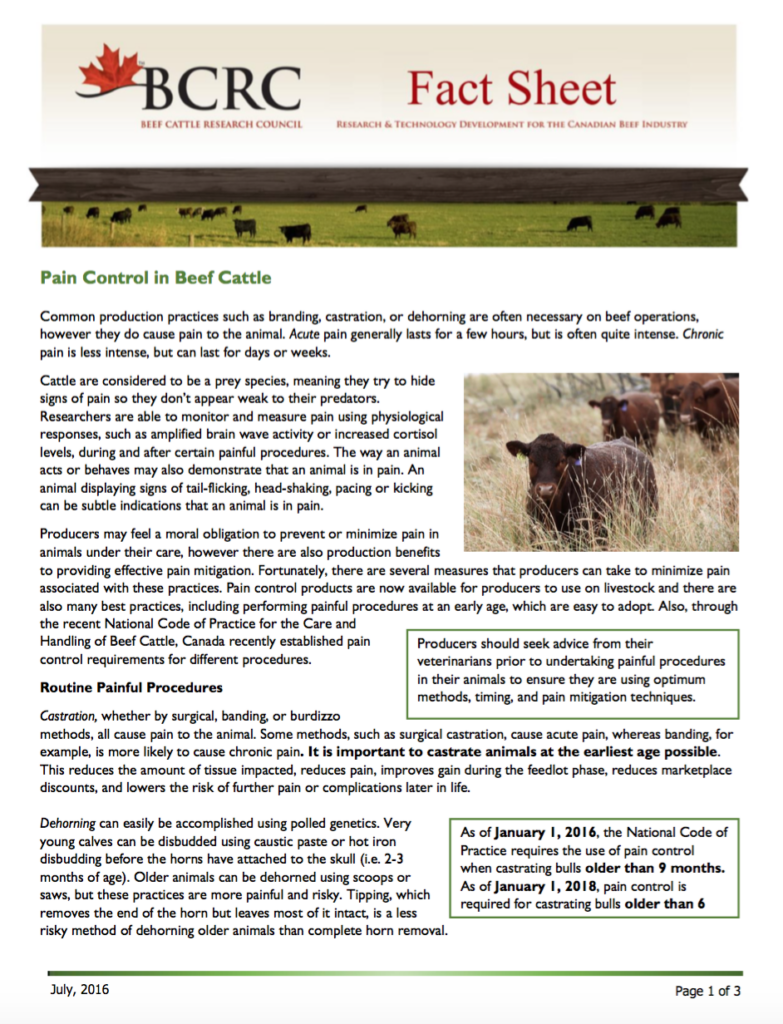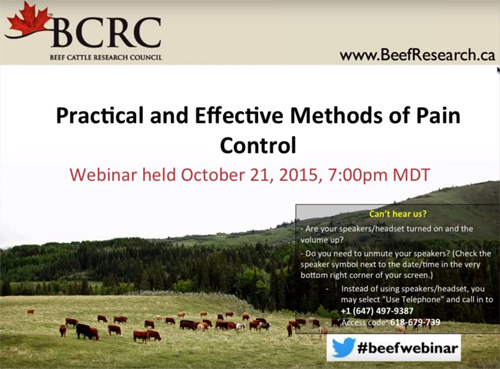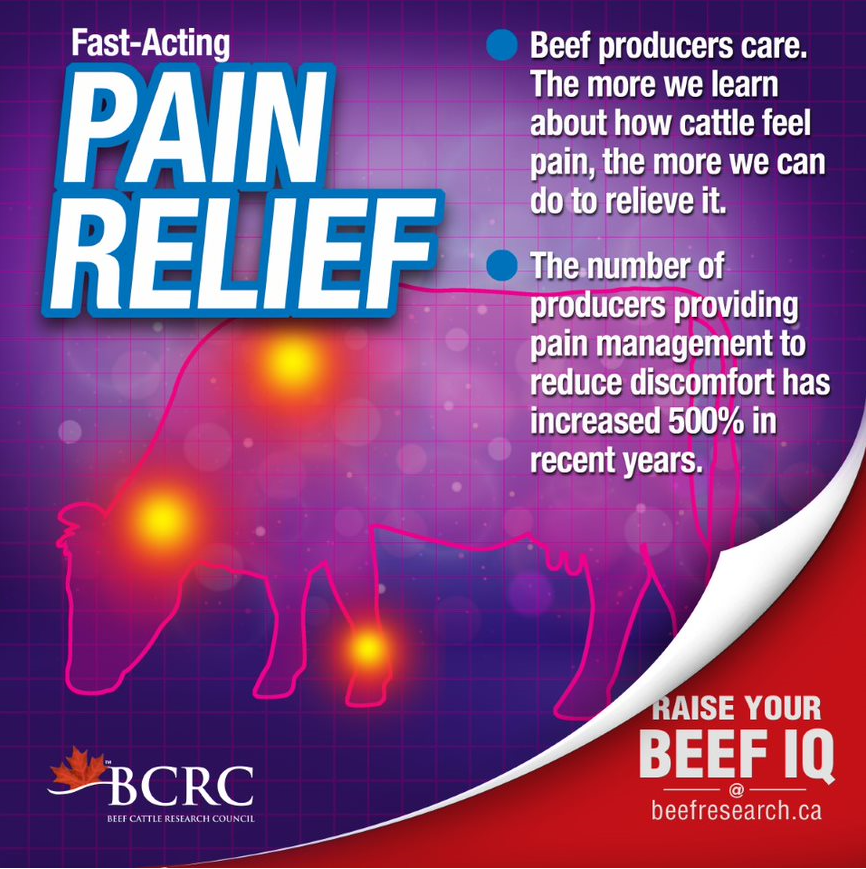
Pain Mitigation in Beef Cattle
Public pressure to avoid painful practices on cattle when possible, and to reduce pain when castration, dehorning, or branding are necessary, continues to build. Canada’s Code of Practice for the Care and Handling of Beef Cattle also makes strong statements about pain control.
Our knowledge of pain in livestock has advanced steadily over the past 22 years. Behavioural and physiological indicators of pain have been identified, and researchers’ ability to measure animal responses associated to painful procedures have improved. Research has developed new pain control drugs that are registered for use in cattle in Canada, and knowledge is increasing on the appropriate dosage, routes of administration and synergy between anesthetics and analgesics.
Introduction
Despite a considerable amount of research, we still don’t fully understand how cattle experience pain. As prey animals, however, cattle have evolved to not show behavioural signs of pain in order to avoid attracting the attention of predators.
Early research into pain control for castration and dehorning was done in dairy calves that were weaned at birth, or in feedlot calves. Until recently, little or no research had been done in young beef calves in a herd environment. This is important, because the relief that beef calves get when they return to their mothers and nurse may help them cope with pain.
Recent Canadian research has developed practical and effective pain control strategies for cattle. Many earlier studies had used drugs in ways that were difficult to implement in commercial practice, or used elaborate combinations of drugs, some of which were not licensed for use in cattle. Other experiments repeatedly administered pain drugs over several days, requiring additional handling, stress and risk of injury for the cattle.
Assessing Pain
To effectively mitigate pain, we must first know if animals exhibit physiological and behavioural responses indicative of stress/pain. Currently pain in animals can only be routinely assessed using behavioural and physiological responses. Depending upon the management procedure being evaluated, researchers have used standing, lying, feeding, ruminating, kicking, tail-flicking, ear-flicking, pacing posture, and weight shifting behaviours to gauge animal responses to painful practices and pain control. These behaviours can be recorded, counted, and statistically compared. Acute, immediate pain is easier to measure than chronic, long-term pain (lasting more than 3 days).
Acute pain: short-lasting, intense pain
Chronic pain: less intense, longer lasting pain
Researchers have found that dehorned calves do more head rubbing, head shaking and ear-flicking than calves that have not been dehorned. Castrated calves stand, move and lie differently than calves that have not been castrated. Pain drugs alter these behavioural differences; bulls that are castrated using pain mitigation drugs show fewer of these abnormal, pain-related behaviours.
Painful Procedures
In Canada the most common routine management procedures that cause pain are castration, dehorning, and branding. Ongoing research is focused on developing ways to reduce pain during these procedures or identifying effective alternative practices.
Castration
Castration, the removal or inactivation of the testicles, is used as a management tool. Castration avoids unwanted breeding, reduces aggression, improves worker and animal safety, improves carcass quality, and avoids price discounts.
All methods of castration are painful. Surgical castration causes more intense acute pain that lasts for a few days, followed by less chronic pain. Banding castration causes less intense acute pain, but more prolonged chronic pain that lasts for more than one month. Acute pain may reappear when the scrotum sloughs off. See the Castration page for more information on different castration methods.
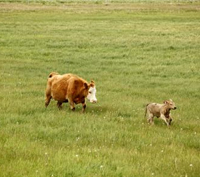
Castrating cattle at older ages can negatively affect animal welfare, health and performance. Canada’s Code of Practice for the Care and Handling of Beef Cattle requires that cow-calf producers castrate calves as young as possible. Castration soon after birth results in improved feedlot health and performance, and enhanced carcass marbling and tenderness compared to castration at or after weaning.
If bulls are castrated after arrival at the feedlot, providing pain control will likely alleviate some of the inflammatory pain associated with castration, but feedlot growth performance will still be negatively affected. Therefore, steep discounts on intact or belly bulls at fall calf sales are expected to continue, even if the feedlot uses pain mitigating drugs when castrating.
Canada’s Code of Practice for the Care and Handling of Beef Cattle requires that:
- Castration be performed by competent personnel using proper, clean, and well-maintained tools
- Producers seek guidance from their veterinarian regarding optimum methods, timing, and pain control
- Animals be castrated as young as practically possible, before the age of three months and especially before weaning
- Pain control be used when castrating bulls older than 6 months
Dehorning
Dehorning decreases the risk of injury for both handlers and other cattle and minimizes the economic loss due to carcass bruising.
Horns are a shell made of keratin and other proteins over a core of living bone. The horn is not attached to the skull at birth. Horn attachment occurs at two to three months of age. Removing horns before they have attached to the skull (disbudding) is less painful than removing attached horns.
Tipping is an alternative to dehorning in animals with large horns. When done properly, tipping (removing the sharp tip, leaving a blunt horn) is less painful than dehorning, because the nerves do not extend to the tip of the horn. Tipping is similar to not dehorning at all based on the evaluation of vocalization, depression, gait, posture, lying, bleeding and healing.
Dehorning can be avoided through the use of polled genetics. Research into the performance of polled vs. horned bulls of many different breeds has shown no differences in any production performance measures.
See the Dehorning page for more information on different dehorning methods.
Canadian beef producers are doing a good job at reducing the number of cattle with horns. According to the latest National Beef Quality Audit, fewer than 10% of fed and non-fed cattle and processed in Canada in 2016-17 had horns.
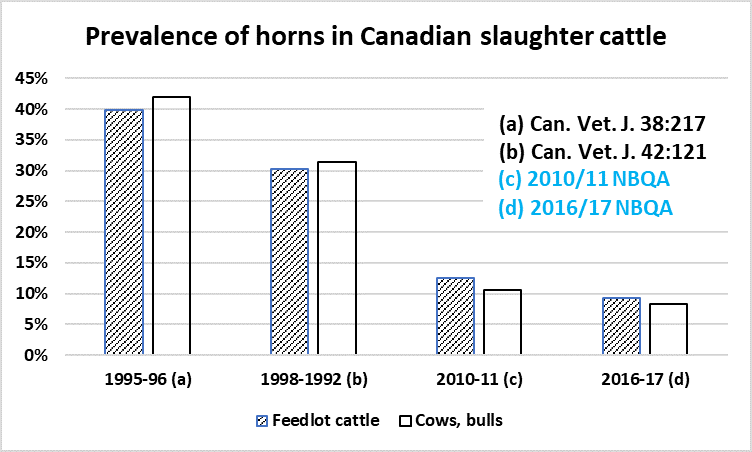
Canada’s Code of Practice for the Care and Handling of Beef Cattle requires that:
- Dehorning be performed by competent personnel using proper, clean, and well-maintained tools
- Producers seek guidance from their veterinarian on pain control availability
- Disbud calves as early as possible, while horn development is in the bud stage (2- 3 months of age)
Use pain control in consultation with your veterinarian when dehorning after the horn bud has attached
Branding
Branding is one of the few permanent methods of animal identification that is easy to identify from a distance and legally accepted as proof of ownership. Branding may be required by community pastures, lending institutions or for export.
Both hot-iron and freeze branding can be used as forms of permanent identification. When done properly, hot-iron branding produces a scar where hair doesn’t grow back (or grows to a different length or color). Properly applied freeze brands cause the hair to grow back white, so they are best suited for dark colored cattle. Applying a freeze brand for too long damages the hair follicles more severely or kills them altogether and is effectively the same as a hot iron brand. Although both types of branding are known to cause pain, hot iron branding has been shown to cause more acute pain at the time of the procedure.
There are no licensed pain control products in Canada with a claim for alleviating the pain associated with freeze or hot iron branding in cattle. Until practical alternatives to branding are available, Canada’s Code of Practice for the Care and Handling of Beef Cattle requires that:
- When branding is required for export, by policy, or as permanent proof of ownership, it must be performed with the proper equipment, restraint and by personnel with training or sufficient combination of knowledge and experience to minimize pain to the animal.
- Do not brand wet cattle due to risk of scalding.
The incidence of branded beef cattle is continually decreasing in Canada. The most recent National Beef Quality Audit found that the use of brands dropped from 49% of fed cattle in 1999 to 13% in 2016/17; of these, 0.3% had more than one brand.
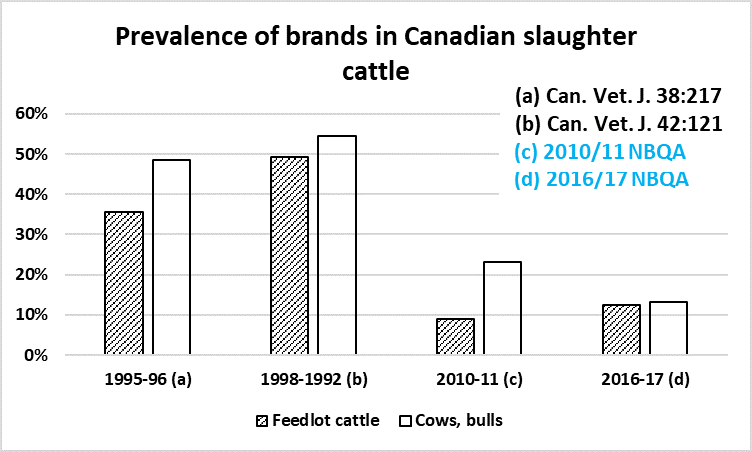
Pain Mitigation Techniques
Ensuring that procedures are performed as early in the calf’s life as possible, by a competent operator using clean, properly maintained tools, is the simplest way to reduce pain during painful routine management procedures
Ensuring that painful procedures are performed as early in the calf’s life as possible, by a competent operator using clean, properly maintained tools, is the simplest way to reduce pain during painful routine management procedures. Use of anesthetics or analgesics can also help to control pain in calves of all ages, but especially in older animals. Work closely with your local veterinarian to develop a pain mitigation strategy that works on your farm.
Age of animal
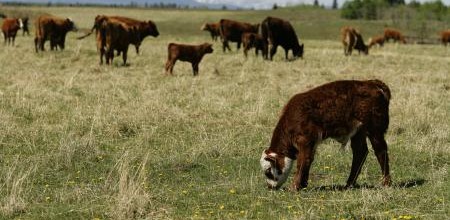
Castration and dehorning are much less invasive in young animals. The wound is smaller, there is considerably less blood loss, and young calves recover more quickly with a smaller setback in animal performance. Research shows that to reduce pain, procedures should be conducted when animals are as young as possible.
Painful procedures should not be performed during times when the animal will be experiencing other stressors (e.g. don’t castrate at the same time as weaning). Stress reduces the animal’s immune system, which makes them more vulnerable to disease.
Using drugs for pain control
Anesthetic: Temporarily blocks all sensation including pain (e.g. Lidocaine)
- Local anesthetic: causes numbness in a particular area
- General anesthetic: cause unconsciousness
Analgesic: Temporarily eliminates pain but not all sensation (e.g. Non-steroidal anti-inflammatories or NSAIDs).
Anesthetic and analgesic drugs that help control pain are commercially available for cattle, and these all require a veterinary prescription.
Anesthetic drugs (like freezing at a dentist) eliminate all feeling. Anesthetics (e.g. Lidocaine) help to reduce the pain of surgery but wear off relatively quickly and are challenging to use. They need to be injected very carefully and precisely around the horn base or in the scrotum, so they may require more restraint so that the person with the needle doesn’t accidentally inject him- or herself. Anesthetics need to be injected 5 to 20 minutes before castrating or dehorning to ensure the animal feels no pain during the operation (and therefore reduces struggling and improves operator safety). Injecting anesthetics immediately before the operation will not help with operative pain but can still provide effective post-operative pain control for several hours (provided the anesthetic isn’t injected into the testicles immediately before they are removed).
Analgesics drugs may be a better option for cattle producers. Analgesics do not eliminate pain at the time of castration or dehorning and can be given immediately before the operation. Analgesics are longer-lasting than anesthetics and may provide some pain relief for up to four days, depending on the drug administered. Analgesics are available in injectable, oral, and pour-on formulations. Numerous Canadian research projects have demonstrated that analgesics help alleviate castration pain post-weaning, as well as in two-month and one-week old calves.
Research shows that a combination of anesthesia and analgesia provides the best pain control.
Producer adoption of pain control for castration has increased significantly in recent years. In 2014, 4% of Western Canadian cow-calf producers reported using pain control for castration, and 9% reported using pain control for dehorning. By 2017, 10-28% of Canadian cow-calf producers reported using pain control for castration, with another 14-23% using pain control depending on castration age and method. In 2017, 27-31% of Canadian cow-calf producers reported using pain control for dehorning, with another 14-23% using pain control depending on dehorning age and the method used.
Pain Control Products Licensed and Available for Beef Cattle in Canada*
Local Anesthesia
| Drug | Brand Name | Route of Administration (ROA) | Label Claim |
|---|---|---|---|
| Lidocaine + Epinephrine | Lido-2 | Epidural Infiltration Nerve Block |
A local anesthetic, Lidocaine 2% injection is used to provide prompt and lasting local anesthesia during certain surgical procedures and is approximately twice as effective as procaine. |
| Lidocaine HCL 2% and Epinephrine Injection USP | Epidural Infiltration Nerve Block |
A fast-acting local anesthetic that produces approximately twice the area of anesthesia produced by equal concentrations of procaine. Lidocaine hydrochloride is the 2-(diethylamino)-2’,6’-acetoxylidide monohydrochloride. Epinephrine is added to prolong the duration of anesthesia and to reduce systemic absorption. | |
| Lidocaine Hydrochloride 2% with Epinephrine 1:100,000 | Epidural Infiltration Nerve Block |
Lidocaine Hydrochloride is a potent local anesthetic. Lidocaine provides more intensive and more extensive anesthesia than procaine. The addition of epinephrine prolongs the action and decreases the toxicity by slowing systemic absorption. The onset of mucosal anesthesia appears in minutes and the effect persists for 30 minutes or more. | |
| Lidocaine | Lurocaine | Epidural Infiltration Nerve Block |
A fast-acting local anesthetic agent which can be used for infiltration or conduction (nerve blocking) anesthesia. It is twice as potent as procaine hydrochloride and produces more prompt, longer lasting and more extensive anesthesia than the latter preparation. |
Non-Steroidal Anti-inflammatories (NSAIDS)
| Drug | Brand Name | ROA | Label Claim |
|---|---|---|---|
| Acetylsalicylic Acid | ASA Bolus | Oral | To be used as an aid in the symptomatic relief of pain. |
| ASEN 240 BOLUS | Oral | To be used as an aid in the symptomatic relief of pain. | |
| ASEN P POWDER | Oral | To be used as an aid in the symptomatic relief of pain. | |
| Flunixin meglumine | Banamine | IV | Banamine is indicated for the control of pyrexia associated with Bovine Respiratory Disease (BRD), endotoxemia and acute bovine mastitis. Banamine is also indicated for the control of inflammation associated with endotoxemia. |
| Banamine | Transdermal (Pour on) | For the reduction of pyrexia associated with bovine respiratory disease (BRD). For the control of pain associated with foot rot in beef and non-lactating dairy cattle. | |
| Flunazine | IV | Flunazine® is indicated for the control of pyrexia associated with Bovine Respiratory Disease (BRD), endotoxemia and acute bovine mastitis. Flunazine® is also indicated for the control of inflammation associated with endotoxemia. |
|
| Vetonixin | IV | Vetonixin Injection is indicated for the control of pyrexia associated with Bovine Respiratory Disease (BRD), endotoxemia and acute bovine mastitis. Vetonixin Injection is also indicated for the control of inflammation associated with endotoxemia. In clinical studies, flunixin as an adjunct to antibiotic therapy with oxytetracycline has been demonstrated to control pyrexia associated with bovine respiratory disease. | |
| Ketoprofen | Anafen | IV IM |
Anafen® is recommended for the symptomatic treatment of fever, pain and inflammation associated with a variety of conditions including respiratory tract infections, mastitis, udder edema, downer cow syndrome, endotoxemia, simple gastrointestinal disorders, arthritis and traumatic musculoskeletal injuries. |
| Ketoprofen V | IV IM |
Ketoprofen V is recommended for the symptomatic treatment of fever, pain and inflammation associated with a variety of conditions including: respiratory tract infections, mastitis, udder edema, downer cow syndrome, endotoxemia, simple gastrointestinal disorders, arthritis and traumatic musculoskeletal injuries. | |
| Meloxicam | Meloxicam Oral Suspension | Oral | For alleviation of pain and inflammation following surgical and band castration in cattle. |
| Meloxidyl® 20 MG/ML | SQ IV |
As an aid in improving appetite and weight gain when administered at the onset of diarrhea, in combination with oral rehydration therapy, in calves over one week of age. For relief of pain following de-budding of horn buds in calves less than 3 months of age. For the symptomatic treatment of inflammation and pain associated with acute clinical mastitis. For the reduction of pain associated with abdominal surgery such as caesarean section. | |
| Metacam® 20 mg/mL Solution for Injection | IV SQ |
As an aid in improving appetite and weight gains when administered at the onset of diarrhea, in combination with oral rehydration therapy, in calves over one week of age. For relief of pain following de-budding of horn buds in calves less than 3 months of age. For the symptomatic treatment of inflammation and pain associated with acute clinical mastitis. For the reduction of pain associated with abdominal surgery such as caesarean section. | |
| Rheumocam 15 mg/mL oral suspension for cattle | Oral | For alleviation of pain and inflammation following surgical and band castration in cattle. | |
| Rheumocam injection | SQ IV |
As an aid in improving appetite and weight gains when administered at the onset of diarrhea, in combination with oral rehydration therapy, in calves over one week of age. For relief of pain following de-budding of horn buds in calves less than 3 months of age. For the symptomatic treatment of inflammation and pain associated with acute clinical mastitis. For the reduction of pain associated with abdominal surgery such as caesarean section. |
Steroids
| Drug | Brand Name | ROA | Label Claim |
|---|---|---|---|
| Dexamethasone | Dexacort 2 | IV IM |
A corticosteroid indicated as an aid in the treatment of bovine ketosis and as an anti-inflammatory agent |
| Dexacort 5 | IV IM |
A corticosteroid indicated as an aid in the treatment of bovine ketosis and as an anti-inflammatory agent | |
| Dexacort Powder | Oral | For the treatment of arthritis and inflammatory conditions involving joints and accessory structures in cattle. For supportive therapy in pneumonia, rhinitis and other respiratory conditions, osteoarthritic lameness and various stress conditions in cattle such as ketosis and metritis, dystocia, and retained placenta. | |
| Dexamethasone 2 | IV IM |
Indicated as an aid in the treatment of bovine ketosis and as anti-inflammatory agent | |
| Dexamethasone 5 | IV IM |
Indicated as an aid in the treatment of bovine ketosis and as anti-inflammatory agent | |
| Dexamethasone 21 Phosphate Injection U.S.P. 5 Mg/mL | IV IM |
An anti-inflammatory and gluconeogenic steroid for cattle and horses | |
| Dexamethasone Injection | IV IM |
Dexamethasone is an anti-inflammatory agent for use in the treatment of arthritis and also ketosis (in cattle). | |
| Dexamethasone Powder | Oral | May be used in those conditions known to respond to corticosteroid therapy such as certain inflammatory, allergic or dermatological conditions. | |
| Dexone | Oral | Recommended as primary therapy for the treatment of arthritis and inflammatory conditions involving joints and accessory structures. For supportive therapy, this dosage form is indicated in pneumonia, rhinitis and other respiratory conditions, osteoarthritic lameness and various stress conditions in cattle and horses such as ketosis and metritis, dystocia and retained placenta in cattle | |
| Isoflupredone acetate | Predef 2X | IM | As with other adrenal steroids, this preparation has been found useful in alleviating the pain and lameness associated with generalized and acute localized arthritic conditions in large animals. Predef 2X sterile aqueous suspension has been used successfully to treat laminitis, rheumatoid and traumatic arthritis, osteoarthritis, periostitis, tendinitis, tenosynovitis, bursitis, and myositis. Generalized muscular soreness, stiffness, depression, and anorexia resulting from overwork, shipping, unusual physical exertion, etc., respond promptly. Remission of symptoms may be permanent, or symptoms may recur, depending on the cause and extent of structural degeneration. |
* Every effort has been made to ensure the accuracy of the information above. However, it remains the responsibility of the readers to familiarize themselves with the product information contained on the Canada product label or package insert. Ensure label directions and veterinarian instructions are followed when using any veterinary product.
The above-mentioned routine procedures are performed to enhance the long-term health and welfare of cattle, their herdmates, their handlers and to improve meat quality (e.g. bruising and dark cutting). Accidents, injuries, sickness or disease may also put cattle in painful situations. In these cases, euthanasia can be the most humane decision for the animal.
Euthanasia
Euthanasia is defined as the humane death of an animal without inflicting pain or distress using methods that cause an immediate loss of consciousness followed by cardiac and respiratory arrest and death without a return to consciousness.
Having a euthanasia decision-making process in place on your farm, along with proper training in both determining when euthanasia should occur and a proper euthanasia procedure will help to minimize unnecessary pain and distress to animals.
Canada’s Code of Practice for the Care and Handling of Beef Cattle requires that animals be immediately euthanized (or culled with proper adherence to the requirements for transporting compromised cattle) if they:
- Have chronic, severe, or debilitating pain and distress
- Are unlikely to recover
- Have failed to respond to treatment or recovery protocols
- Are unable to get to or consume food and water
- Show continuous weight loss or emaciation
There are many acceptable ways of on-farm euthanasia; choosing the best method depends on the individual animal, location, and person who will be euthanizing the animal. Before deciding on a form of euthanasia, consider animal welfare, human safety, carcass disposal, and the potential need for tissue collection for diagnostic purposes. Refer to page 30 of Canada’s Code of Practice for the Care and Handling of Beef Cattle for approved methods and guidelines.
Further Research
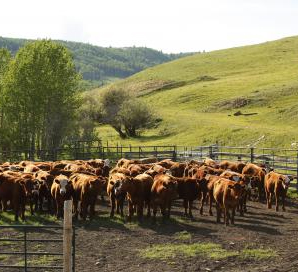
There is still much we do not understand when it comes to the effect and management of pain-associated procedures like castration and dehorning. It is important to note that beef cattle may respond differently to dehorning than dairy cattle due to their fear response to handling and restraint.
Continued research on practical methods of mitigating pain and encouraging wound healing after castration would be valuable. There is also work to be done in assessing chronic pain associated with banding. New products and delivery methods would be welcome.
Producer Testimonial
For Saskatchewan beef producers Tamara and Russ Carter administering a pain control product to calves prior to branding and castration procedures was just the right thing to do. Over the past three calving seasons the Carters, who ranch near Lacadena in southwest Saskatchewan, have been treating spring calves with an injection of Metacam just prior to processing. Read about their experience on the BCRC Blog.
- References
-
Code of Practice for the Care and Handling of Beef Cattle https://www.nfacc.ca/pdfs/codes/beef_code_of_practice.pdf Coetzee JF, Gehring R, Tarus-Sanf J, Anderson DE (2010) Effect of sub-anesthetic xylazine and ketamine (‘ketamine stun’) administered to calves immediately prior to castration. Veterinary Anaesthesia and Analgesia;37:566-578. Coetzee JF, Edwards LN, Mosher RA, Bello NM, O’Connor AM, Wang B, KuKanich B, Blasi DA (2012) Effect of oral meloxicam on health and performance of beef steers relative to bulls castrated on arrival at the feedlot. Journal of Animal Science 90:1026-1039. Gonzalez LA, Schwartzkopf-Genswein KS, Caulkett NA, Janzen E, McAllister TA, Fierheller E, Schaefer AL, Haley DB, Stookey JM, Hendrick S (2010) Pain mitigation after band castration of beef calves and its effects on performance, behavior, Escherichia coli, and salivary cortisol. Journal of Animal Science 88(2):802-810. Marti, S, Meléndez, D.M., Pajor, E.A., Moya, D, Heuston, C.E.M., Gellatly, D., Janzen, E.D. and Schwartzkopf-Genswein, K.S. (2017). Effect of band and knife castration of beef calves on welfare indicators of pain at three relevant industry ages: II. Chronic pain. J. Anim. Sci. 95:1–14. doi:10.2527/jas2017.1763 Marti, S, Meléndez, D.M., Pajor, E.A., Gellatly, D., Janzen, E.D. and Schwartzkopf-Genswein, K.S. (2017). Use of topical healing agents on scrotal wounds after surgical castration in weaned beef calves. Can. Vet. J. 58:1081-1085 Marti, S, Meléndez, D.M., Pajor, E.A., Moya, D, Heuston, C.E.M., Gellatly, D., Janzen, E.D. and Schwartzkopf-Genswein, K.S. (2018). Effect of a single dose of subcutaneous meloxicam before knife castration alone or combined with hot-iron branding on scrotal healing, inflammatory response, and behaviour in 2-mo-old beef calves over 42 d post procedure. Can. J. Anim. Sci. dx.doi.org/10.1139/cjas-2018-0016 Marti, S, Meléndez, D.M., Pajor, E.A., Moya, D, Gellatly, D., Janzen, E.D. and Schwartzkopf-Genswein, K.S. (2018). Effect of a single dose of subcutaneous meloxicam prior to band or knife castration in 1-wk-old beef calves: II. Inflammatory response and healing. J. Anim. Sci. 96. doi: 10.1093/jas/sky291 Meléndez, D.M., Marti, S., Pajor, E.A., Moya, D., Heuston, C.E.M., Gellatly, D., Janzen, E.D. and Schwartzkopf-Genswein, K.S. (2017). Effect of band and knife castration of beef calves on welfare indicators of pain at three relevant industry ages: I. Acute pain. J. Anim. Sci. 95. doi:10.2527/jas2017.1762 Meléndez, D.M., Marti, S., Pajor, E.A., Moya, D., Gellatly, D., Janzen, E.D. and Schwartzkopf-Genswein, K.S. (2017). Effect of timing of subcutaneous meloxicam administration on indicators of pain after knife castration of weaned calves. J. Anim. Sci. 95:5218–5229. doi:10.2527/jas2017.1978 Meléndez, D.M., Marti, S., Pajor, E.A., Moya, D., Gellatly, D., Janzen, E.D. and Schwartzkopf-Genswein, K.S. (2018). Effect of subcutaneous meloxicam on indicators of acute pain and distress after castration and branding in 2-mo-old beef calves. J. Anim. Sci. 96:3606–3621. doi: 10.1093/jas/sky245 Moya D, González LA, Janzen E, Caulkett NA, Fireheller E, Schwartzkopf-Genswein KS (2014) Effects of castration method and frequency of intramuscular injections of ketoprofen on behavioral and physiological indicators of pain in beef cattle. Journal of Animal Science 92:1686-1697. Neely CD, Thomson DU, Kerr CA, Reinhardt CD (2014) Effects of three dehorning techniques on behavior and wound healing in feedlot cattle. Journal of Animal Science 92:2225-2229. Schwartzkopf-Genswein KS, Fierheller EE, Caulkett NA, Janzen ED, Pajor EA, et al. (2012) Achieving pain control for routine management procedures in North American beef cattle. Animal Frontiers 2: 52-58. http://www.animalfrontiers.org/content/2/3/52.full Schwartzkopf-Genswein K.S., Stookey J.M., de Passillé A.M. & Rushen J. (1997) Comparison of hot-iron and freeze branding on cortisol levels and pain sensitivity in beef cattle. Canadian Journal of Animal Science 77:369-374. Schwartzkopf-Genswein, K.S., Stookey J.M. & Welford R. (1997) Behavior of cattle during hot-iron and freeze branding and the effects on subsequent handling ease. Journal of Animal Science 75:2064- 2072. Stookey JM, and Goonewardene LA. (1996) A comparison of production traits and welfare implications between horned and polled beef bulls. Canadian Journal of Animal Science 76:1.
Feedback
Feedback and questions on the content of this page are welcome. Please e-mail us
Acknowledgements
Thanks to Dr. Karen Schwartzkopf-Genswein, Dr. Daniela Meléndez Suárez (Research Scientists, Agriculture and Agri-Food Canada), and Dr. John Campbell (Professor, Western College of Veterinary Medicine, University of Saskatchewan) for contributing their time and expertise during the development of this page.
Expert Review
This content was last reviewed May 2020.
Ce contenu a été révisé pour la dernière fois en Octobre 2023.
